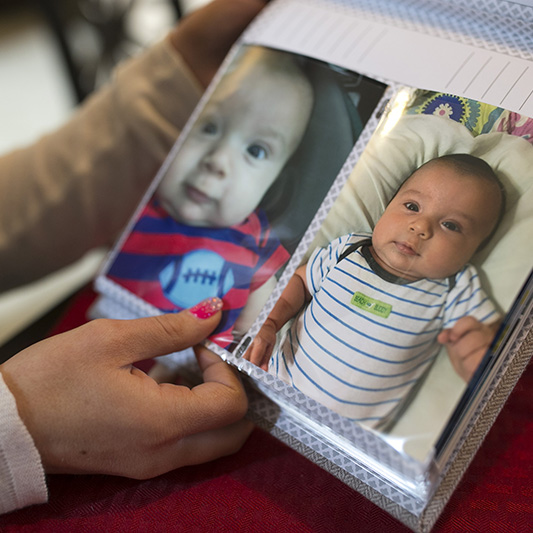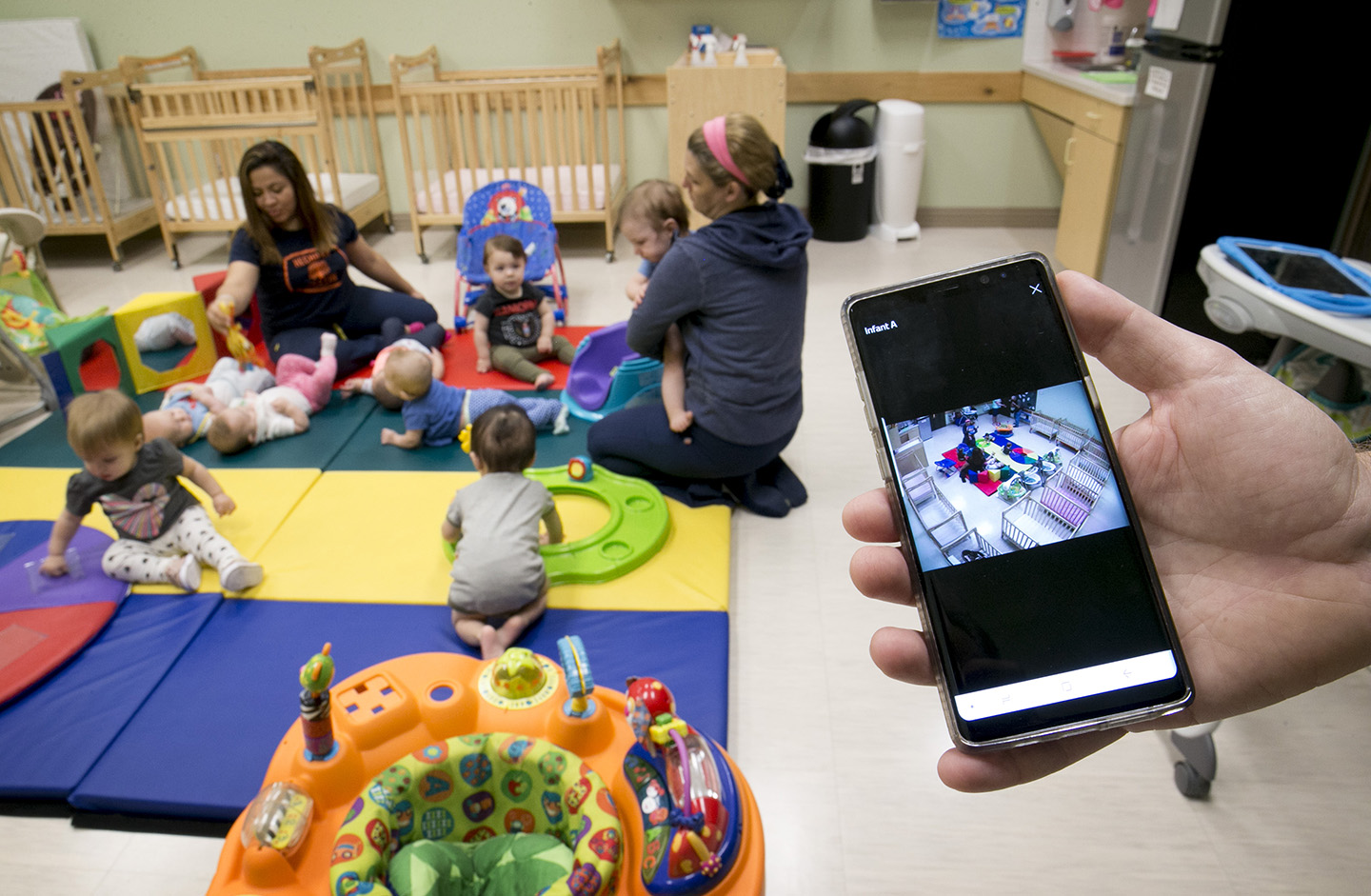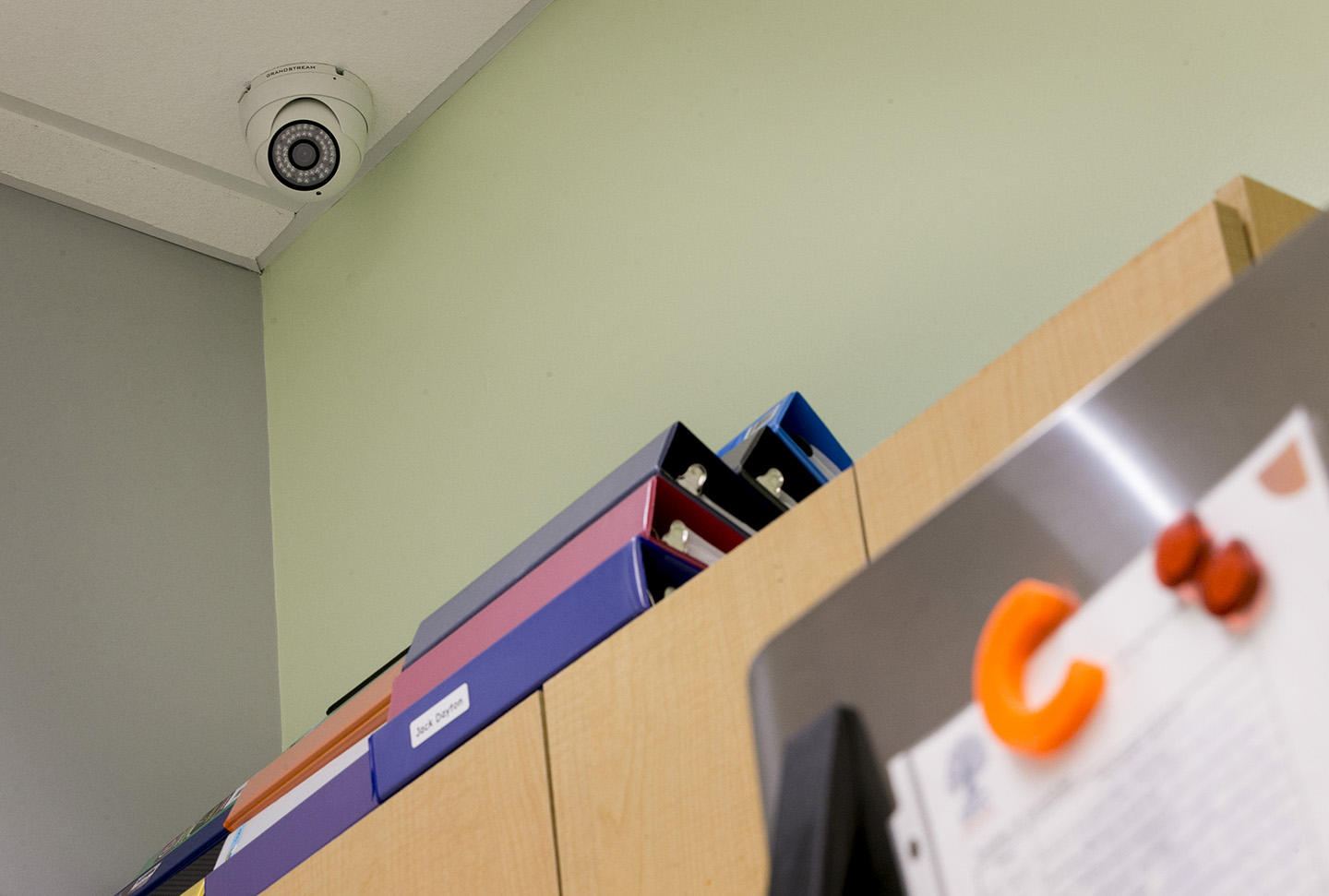Safety Solutions
How to keep our children
and their caretakers in Texas
day cares from going
unwatched
How Texas lawmakers
could make day cares safer, if
they fought for it

By Andrea Ball and Sean Collins Walsh
Austin American-Statesman | Dec. 6 2018
When Shawna Diaz’s infant son died at Bibs and Cribs Advance Learning Center, there was one place the Houston mother thought she could turn to for answers: the day care center’s video cameras.
On Nov. 2, 2016, 3-month-old Shane Martinez was found unresponsive and covered in vomit in his day care crib. He had stopped breathing and died the next morning. The doctors ruled the cause of death sudden infant death syndrome.
Diaz, stunned that her youngest son had died so suddenly, had seen a video camera at the day care center and prayed the footage could shed some light on what had happened.
But the cameras were off that day. In fact, they had been off for some time. In a deposition for a lawsuit Diaz filed, owner Audris Haynes said that she had only purchased the cameras because she suspected employees were stealing diapers and she wanted to catch them.
“It wasn’t put there to monitor the care of the kids,” Haynes said. “Now, I mean, it could have been used for that but it — but that never came up.”

Because Bibs and Cribs failed to use its cameras to observe children, it took Diaz more than a year to discover that the baby’s caregivers had lied about D placing Shane on his stomach in his crib, something his mother says caused his death.
Now Diaz is working with state Rep. Ana Hernandez, D-Houston, to file a bill requiring cameras in all day care centers.
“I don’t want this to happen to anyone else,” Diaz said. “It’s not fair.”
Diaz’s mission to force all day care facilities to use cameras is just one of a number of ideas that experts and parents say the Legislature could adopt to protect children and their families. An American-Statesman investigation has found nearly 90 deaths and 3,200 abuse and neglect cases over the last decade, as well as more than 450 incidents of sexual abuse at day care facilities in Texas.
The findings are part of the Statesman’s yearlong investigation into these and other problems at Texas child care facilities. The newspaper read thousands of documents, researched dozens of day care safety records, analyzed existing data and built its own database to find patterns and trends.
What the Statesman found was that dangerous conditions exist inside many Texas day care facilities, leaving hundreds of children in need of medical care as well as nearly 90 children dead as a result of abuse or neglect since 2007. In this series, the newspaper explores problems such as day care sexual abuse, deaths, injuries, illegal operations and state oversight. The newspaper also presents potential solutions to some of those problems.
In addition to cameras, potential solutions include:
- Reinstituting a state unit devoted to finding illegal child care operations, where the largest number of child day care abuse and neglect deaths occur.
- Requiring day care facilities to increase the number of caregivers watching children.
- Increasing oversight of the two smallest types of legal child care, which care for 55,000 children.
- Forcing all child care operations to carry liability insurance.
What’s the problem?
Cameras are not required in day cares, which could be used in case of injury or death to know what went wrong
What can be done?
- Require day care centers to place cameras in classrooms
Which lawmaker is working on it?
Rep. Ana Hernandez, D-Houston
While the concept of cameras in child care centers might seem straightforward, it is fairly complicated.
Many day cares already use cameras in their facilities, some of which offer livestreaming so parents can check on their children at any time. But Traci Mackintosh, former president of the Texas Licensed Child Care Association, said cameras remain a controversial industry topic. Her organization thinks the use of recording devices should be made by individual operators.
“Parents feel it is a comfort thing,” she said. “Staff, even quality staff who you would never think did anything wrong, may not want to work in a place with cameras. They feel like they are being watched, and every single thing is being scrutinized.”
She said she also knows some parents who have objected to cameras because they did not like other parents, whom they might not know or trust, being able to watch their children.
Lydia Cisaruk, director of communications for The Children’s Courtyard, which has 44 centers in Texas, including 10 in the Austin area, said its facilities have multiroom displays in the lobby with real-time, closed-circuit feed of classrooms, playgrounds, lobby entrances and exits.

“We view this feature as an extension of our open-door policy and commitment to transparency,” Cisaruk said. “It offers peace of mind, demonstrating our confidence in the high level of care we provide, and addresses recommendations we’ve received from many parents.”
Rep. Hernandez says cameras don’t just protect children. They protect child care operators, who can use the footage if they need to prove they were not culpable in certain situations, she said.
“I would think day cares would be in favor of this,” she said.
Basic security cameras can be purchased for several hundred dollars. More sophisticated systems cost more. The company Watch Me Grow sells camera systems that cost between $2,000 and $20,000, depending on the number of cameras and the type of services requested.
What’s the problem?
Illegal day cares have troublesome safety records
What can be done?
- Reinstate the investigative unit
- Increase funding for subsidies for legal day care tuition for low-income families
Which lawmaker is working on it?
Sen. Kirk Watson, D-Austin
For years, state officials have known that illegal operations are among the least safe day care facilities in Texas.
Between 2007 and 2017, 42 out of 88 children who died as a result of abuse or neglect did so in unregulated, off-the-books child care sites, largely because many operators have no training and might know little to nothing about running a child care facility. The vast majority of illegal child care deaths stem from unsafe sleeping arrangements, something thoroughly addressed in state-required training.
In 2013, legislators created a team in the child protection agency to hunt down illegal child care operations and close them or bring them into compliance — and the results were immediate D. That year, the state found 1,323 unauthorized child cares. A year after the unit kicked off its efforts it discovered 3,651.
Julie Richards, director of day care field operations with the Health and Human Services Commission, says that illegal day care facilities had gotten savvy about hiding their operations and have largely stopped advertising on Craigslist, Facebook and other social media sites.
“We have seen that providers have gotten very clever about where they advertise illegal daycares,” Richards said.
So the best thing to do, she said, was to put more energy into education efforts. Now the state works with doctors offices, child and family groups, health and safety awareness events and school districts to get the word out.
Yet in a recent search of Craigslist child care listings in the Austin area, the Statesman quickly found numerous unregulated operations.
In September 2017, the state dismantled the unit and now only addresses illegal day care operations as they come across them after complaints, injuries or deaths. In 2018, the state found illegal 1,611 child care facilities, a 47 percent decrease from the last year the unit was operating.
State Sen. Kirk Watson, D-Austin, says he will push his fellow lawmakers to provide funding to reinstate the illegal day care unit.
“We need to re-establish that unit,” Watson said. “We need to make sure we’re providing sufficient funding to sustain a workforce that is trying to ensure the safety of these kids.”
The Health and Human Services Commission has said it plans to bring the unit back if lawmakers next year approve a funding boost for the agency to comply with federal block grant requirements.
What’s the problem?
Staffing requirements, a key predictor of safety, are among the most lax in the nation
What can be done?
- Lower the maximum allowed staff-to-child ratios in Texas
Which lawmaker is working on it?
Sen. Judith Zaffirini, D-Laredo
Another area where research shows the state might be able to improve day care safety and quality is its rules for the number of staff members that day care centers must place in classrooms.
All states set maximum child-to-staff ratios for regulated day care centers. For most age ranges, Texas’ required ratios are among the most lenient in the nation and are well below the standards recommended by the National Association for the Education of Young Children. .
Over the past decade, Texas lawmakers and agency leaders have repeatedly rebuffed efforts to bring the state’s ratios in line with the rest of the country or the national standards, arguing it would make day care too costly. The Department of Family and Protective Services in 2016 abruptly pulled its participation from a study comparing staffing levels and injury rates in day care operations, effectively shutting down research that, based on the limited data that were collected, was likely to show that lower maximum ratios would decrease the number of injuries in Texas day care facilities.
“There’s very little appetite at the leadership level to really work on child care quality,” said Stephanie Rubin, CEO of Texans Care for Children. “There’s still too little appetite to address really the most important years for children: the zero to 5 range.”
Texas officials’ stated reasoning for rejecting tighter ratios — that increasing staffing requirements will drive up the cost of day care — is wrongheaded, Rubin said.
“The argument that if you raise standards and oversight that that’ll somehow force parents into unlicensed child care is the wrong way to think about it,” she said. “If our priority is kids in high-quality learning environments, then we’ll do what it takes to make sure they are available, and that may mean some additional resources.”
During the 2017 legislative session, state Rep. Linda Koop, R-Dallas, and Sen. Judith Zaffirini, D-Laredo, filed a bill to force the agency to participate in a redo of the study, but it didn’t pass. Zaffirini said she plans to file a similar bill in the upcoming legislative session.
What’s the problem?
Listed and registered day cares are barely monitored by the state
What can be done?
- Increase standards and oversight for listed and registered in-home day care operations
Which lawmaker is working on it?
No lawmakers have championed this, but child advocates are pressing them to do so
Over the years, some have called for the state to increase regulation of two types of in-home child care operations that receive less oversight than fully licensed centers: registered and listed. Between 2007 and 2017, 29 children died of abuse or neglect in these kinds of child care facilities.
Licensed child care operations in Texas — which care for about 1 million children — are inspected at least once a year. Registered child cares, which can watch up to 12 children, are inspected every two years. Like licensed facilities, registered homes are subject to hundreds of rules dictating how child care facilities must be run, including health, discipline, sleep and food regulations.
“Registered child care homes are a different environment, and they have fewer children in care than licensed operations,” said Carrie Williams, spokeswoman for the Health and Human Services Commission, which oversees child cares. “The caregiver is sometimes a friend or neighbor whom the parent interacts with on a regular basis in the community. The parent often has a more personal relationship with those providers. There tends to be less turnover and more consistency.”
Listed day care operations are not inspected at all and do not have to meet any standards. It costs $20 to sign up.
Listed caregivers undergo a criminal background check, “giving parents that extra measure of information and reassurance, above and beyond a provider operating illegally,” Williams said. These caregivers are on state mailing lists so they receive email blasts with educational and safety information.
But while these types of operations might be on the state’s radar, the state often doesn’t see what happens there unless someone complains.
In one Austin listed home, child care licensing showed up after someone complained that a woman was running an illegal day care facility out of her house and discovered she was watching eight children. After the woman signed up as a listed day care, investigators discovered razors in reach of children, a pellet gun on the night stand of a master bedroom, filthy bathrooms and garbage on counters. The state ultimately revoked the day care facility’s permit to operate.
The Legislature does not appear to have an appetite to beef up regulation of listed and registered homes, though there is a desire to make such day care operations more accountable in another way: requiring them to carry liability insurance.
What’s the problem?
Liability insurance isn’t required for small in-home operations
What can be done?
- Require more day care operations to carry liability insurance
Which lawmaker is working on it?
No lawmakers have championed this
In May 2015, 3-month-old Amani Ball D died after suffocating in the Texas City registered child care where she was staying. Day care owner Divina Archie had placed Amani face down on a bed for her nap, according to state inspection records. Archie, who did not have a crib for the infant, left Amani alone for two hours. The baby asphyxiated. Archie D was charged with criminally negligent homicide and received deferred adjudication.
Amani’s parents sued. But their lawyer, Brent Coon, said the family ultimately dropped the suit because Archie did not have liability insurance.
“They did not want to go through all this heartache and go through all of this to end up with a judgment that was not worth the paper it was printed on,” Coon said.
Under Texas law, all licensed day care centers must have liability insurance, which protects them from lawsuits or similar claims. It also provides parents a way to collect money in case their children are hurt or killed while under the care of these facilities.
Liability insurance can range from $300 to $800 a year, said Jordan Silverman, president of DC Insurance Services Inc. in California.
“In a lot of cases, it’s less expensive than auto insurance, for more coverage and a higher risk,” he said.
But in Texas, in-home day care operations are exempt under state law from having liability insurance, unlike several other states.
“They should, in my opinion,” said David Brown, professor of early childhood education at Texas A&M University-Commerce. “Of course, that’s a cost. But I think everyone should have it.”
While some think liability insurance is important so parents have help covering medical, funeral or other costs that can come from day care incidents, Brown says he thinks it’s important because it would raise the quality of the operation, as insurance companies might demand more quality as a requirement of coverage, he said.
Some insurance companies, for example, might require fencing around playgrounds, put certain restrictions on pets or require a physical inspection of the operation.
Watson said he is generally in favor of liability insurance for any business. The problem is that it costs money, he said, and he doesn’t want to do anything that would make child care less affordable.
“The question is: Does liability insurance keep kids safer?” Watson said. “I don’t know. We have to be smart about it.”